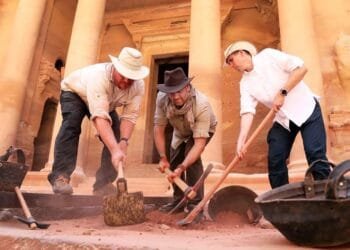San Casciano dei Bagni, in Tuscany’s lush Sienese countryside, is a geothermal hot springs hotspot with forty hot springs, six of which are connected to the thermal sanctuary. The Etruscans chose this location to benefit from the chemical properties of the water, which is high in minerals such as calcium and magnesium, as well as chloride and sulfates.

Archaeologists discovered a treasure trove of artifacts and remains at the site this week, shedding light into the intimate connection Italy’s past civilizations had with “water religion,” or the healing, divine origins of hot springs, the CNN news reported.
Rare artifacts believed to have been used as deity gifts, including fertility figurines in the shape of a phallus, a womb, and a pair of breasts, were discovered from the site’s mud.
So are 3,000 ancient coins, 700 of which are freshly minted and still shiny. In the second century AD, Roman emperor Marcus Aurelius Carus had the coins thrown into the baths to honor the gods who watched over his health and the health of all Romans who visited San Casciano for thermal treatment.

“What makes this site unique in the Mediterranean is its exceptional state of preservation, and the [evidence] it allows for how medical hot water practices were considered curative under divine protection,” said archaeologist Jacopo Tabolli, scientific director of the excavation project and professor of Etruscan studies at Siena’s University for Foreigners.
“The quantity and quality of the objects recovered is also amazing – we knew something was down there but didn’t expect such a surprise.
Residents of San Casciano have traditionally referred to the site as a “sacred mountain,” Tabolli added, citing a 16th-century doctor’s report that notes the presence of ancient buildings and a fountain. A geophysical survey conducted by Tabolli’s team in 2019 revealed the presence of structures on the springs; the following year, ancient columns emerging from a forest were uncovered, and excavation work began (although it was later halted during the pandemic).
The ancient thermal baths of San Casciano functioned as a hospital clinic, with visitors seeking relief from breathing problems or aching legs. Many people found that floating in the water eased their pain, so they threw offerings to the gods into the bubbling pools to thank them for healing them. These include tree branches, fragrant pine cones, and fruits like peaches that have been found in preserved conditions thanks to the mud layers that have since covered the place.
Several relics sculpted in the form of miniature bronze leg, arm, and ear offerings were also discovered. They were left to thank the gods for the healing of specific body parts or to call attention to the prayers of mortals in pain (hence the ear shape).

Womb-shaped offerings were typically made of terracotta during Etruscan and Roman eras. A bronze one discovered in San Casciano, which would have been extremely expensive to commission, is the first of its kind, according to Tabolli, and serves as proof of the importance of this thermal site.
“The discoveries tell us a lot about Italy’s ancient communities,” explained Tabolli, “and advance our research on their social, cultural and religious landscape in relation to the sacred nature of hot water.”
The excavation site currently features one Etruscan pool, known as the “big bath,” that is eleven meters long and five meters deep, and five smaller Roman pools where hot water flows in at a rate of about 2,000 liters per minute. There are fountain and statue remains next to travertine stone altars to Apollo, the god of prophecy and medicine, Isis, the goddess of fertility, and Fortuna Primigenia, the goddess of the firstborn.
Pregnancy and birthing rituals are among the health rituals practiced at thermal baths. Archaeologists believe that ancient women visited San Casciano both during their pregnancies and after birth in the hopes of protecting their baby’s health, based on the discovery of a statue of a naked baby. “Until 50 years ago, village women who had trouble conceiving a child came to the thermal baths in the belief that the water would relax their wombs,” Tabolli explained.
The number of bronze, silver, and orichalcum coins discovered in the big bath is also extraordinary, said Tabolli. It is the largest collection of ancient coinage related to hot springs in the Mediterranean, and it is also notable for its perfect preservation. The coins have retained their original coloring both thanks to the water’s chemical properties and due to being blanketed by mud, which prevented oxidation.

“They’re still shiny brown and shiny yellow — such bright colors have never been found in any excavation site,” Tabolli added. “It’s a miracle.”
The public will soon be able to see the recovered wonders at a new village museum. Local authorities and experts believe the spa still holds more treasures waiting to be uncovered, with its deepest muddy layers holding artifacts dating back to the Etruscan era.
Archaeologists will continue to work at the site, with Tabolli excited about what might next come to light. “I hope to unearth the founding sanctuary in its entirety,” Tabolli said. “We can already spot a pre-Roman layer.” © 2022 Cable News Network, Inc.




























